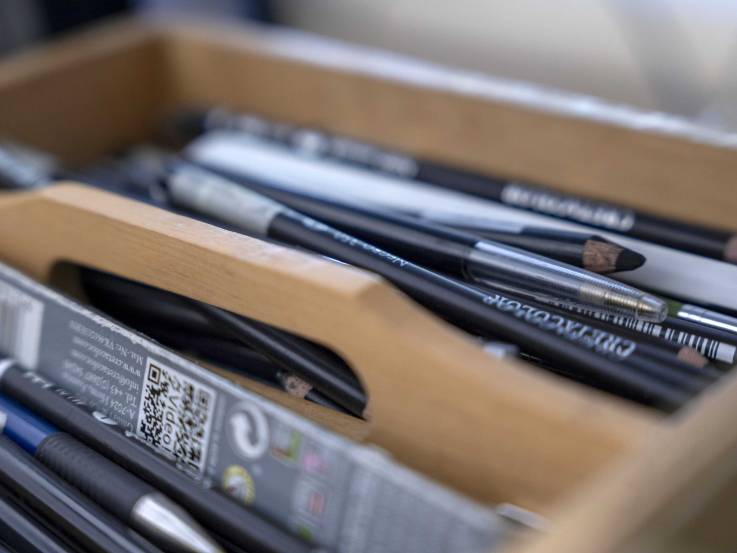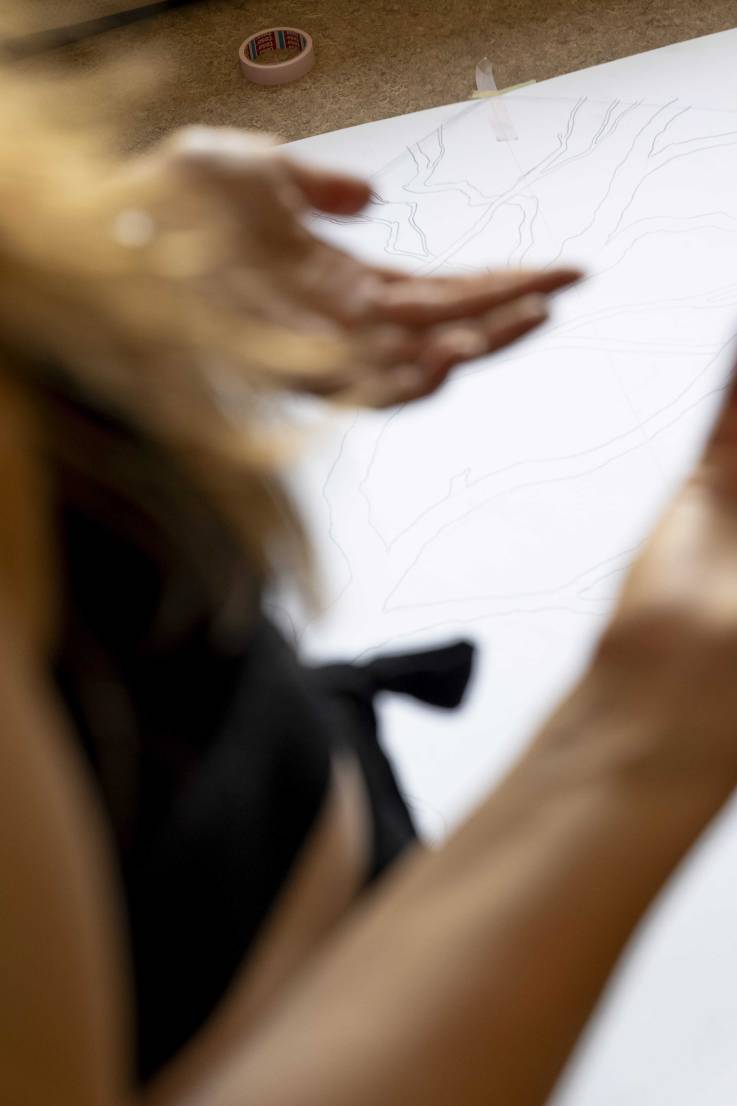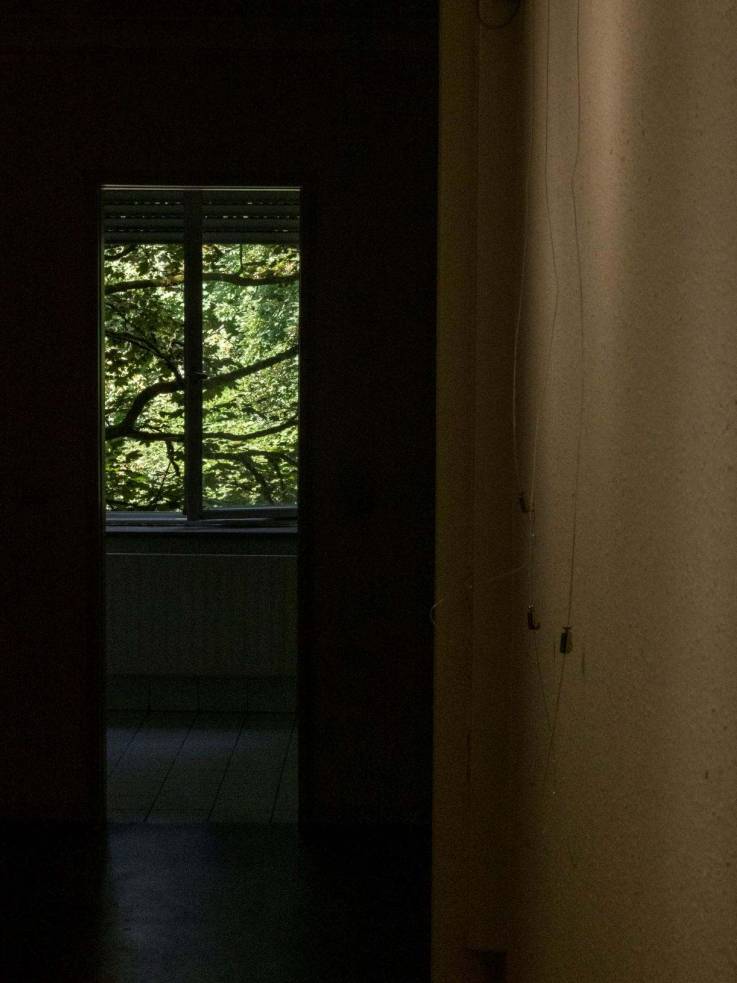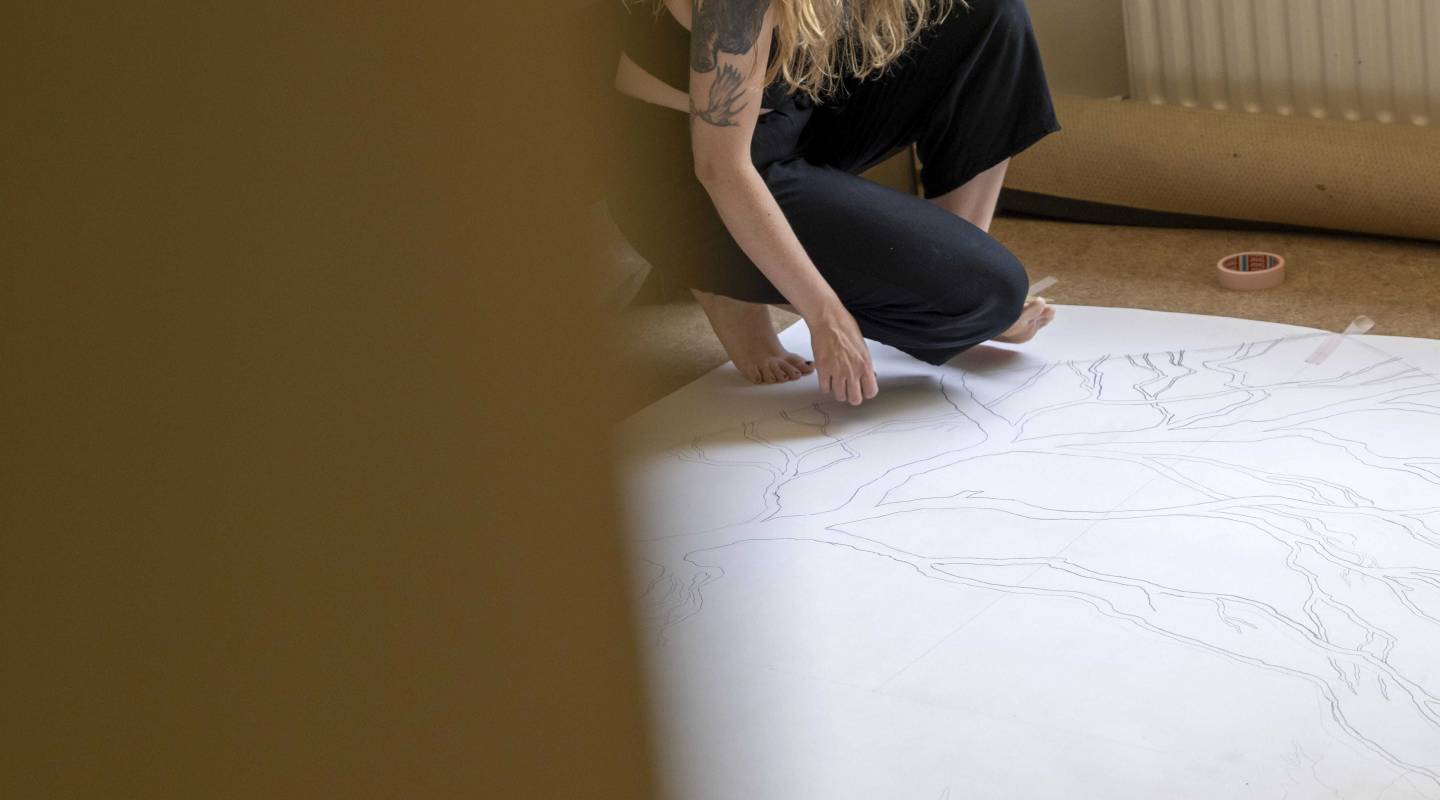We, Lis Hausemer and Michelle Kleyr, from the museum’s Fine Arts Department, visit the young artist Alexandra Uppman in her Bonnevoie studio, where she is preparing for the live drawing project. The final piece will ultimately join the museum’s collection.
Uppman’s proposed composition – a detailed natural forest landscape spread over three tall panels – will come to life between mid-September to mid-November. We meet the artist during the research phase, as she works on the overall design. Her one-room studio features a large drawing desk, but for this occasion, she unrolls her preparatory sketch on the floor to show us. Measuring roughly 3 by 3 metres, this will be her largest drawing to date.

Roots run deep
The subject Alexandra Uppman has chosen is, as she describes, rooted in her personal history. Born in Luxembourg to a Finnish family, she has always felt that forests are a defining feature of both countries’ landscapes. Simply looking at them can evoke in her a profound sense of awe. Her creative process often begins with direct engagement with nature – typically by walking one of Luxembourg’s many forest trails.
The artist frequently includes folkloric references in her work. When she draws inspiration from rituals such as the Luxembourgish tradition of Buergbrennen, it is the sense of timelessness and mysticism that, for her, expresses a deep interconnection between humans and nature. She feels this is especially relevant in our times of environmental destruction and loss of biodiversity. By dedicating her art to the beauty of natural details, from the smallest pollinators to dying trees, she seeks to raise awa-reness of these pressing issues and to inspire greater appreciation and care for forests: “My way of trying to always advocate for a greener future and more respect and love for forests in general has been to show the beauty of them.” erested in learning more, the artist will be available for informal discussions about her work and artistic approach every Thursday in October, between 5pm and 8pm.

From wiggly shapes to sauna ladles
For this large-format work, the artist chose a triptych format. She decided to work at this scale partly because the museum’s spacious setting allowed it, and partly for practical reasons. Since the drawing is ultimately intended for the museum’s collection, it also needed to be designed in a way that made it easy to put up and take down.
The three panels are each crowned by a pointed arch, which lends them the appearance of church windows. This reference is intentional, as the artist explains: “I really like this idea of a window into a bit of a different world, so that the visitor can kind of look through these windows in the museum. And I just really love the shape of gothic windows.” Moving away from a traditional rectangular format aligns with Uppman’s current interest in experimenting in how the shape of a drawing and the materials used can interact to form a unified whole, where form and content become integral to the work itself. “I really like these kinds of weird, wiggly shapes,” she adds, showing us another recent piece. In this work, she has drawn directly onto the wooden surface and framed it in a matching, organically shaped border cut from the same type of wood. The grain runs through both elements, visually connecting frame and drawing so they feel like one continuous structure.
It’s clear that alongside drawing, which has always been the central thread of Uppman’s practice, there’s an ongoing fascination with wood, another link to her broader interest in forests and nature. Her Finnish heritage plays a role in this connection: “I think it’s also kind of an influence I’ve had from Finland and my childhood there. Anything made from wood, like houses, objects, they are so present in Finnish culture.” She points, amused, to a wooden sauna ladle, with similar wiggly, gothic-inspired contours, which she tells us she carved herself; a small, personal nod to her Finnish roots.

Translating moods and atmospheres
What draws Uppman most to drawing, she shares with us, is its remarkable ability to convey moods and atmosphere. Be it through contrasts or shading, “there’s just so much you can do with drawing,” she says with genuine enthusiasm, revealing how deeply connected she feels to the medium. The approaches she’s been exploring, such as incorporating wood-carved elements and other natural materials into her work, have added a new dimension to the atmosphere she seeks to create. These techniques help translate her vision in unexpected ways.
When asked what inspires her, she tells us that her process is mostly based on intuition, especially in response to nature. “When I work, it’s often very feeling-based. I feel so strongly when I look at a landscape. I get this overwhelming sense of, like (sigh), urgh – this is just so beautiful, so breathtaking, and it feels like it just wants to come out.”
It’s often purely visual, aesthetic experiences, like a foggy landscape, that sparks Uppman’s sense of fascination, which she then tries to translate into her drawings. She’s always been drawn to a slightly darker universe, she explains, “but I try to always show the beauty of it – how I see it.” Music is another major source of inspiration, particularly metal, which she often listens to while working. “But I think there’s also a general fascination with storytelling,” she adds. This element of storytelling also occasionally pops up in her work, where one might encounter an unexpected creature or two, reminiscent of childhood tales. Visitors to the museum may also discover such subtle narratives hidden within the forest she creates, inviting them to sit down and take a closer look.

Finding a new balance
The live drawing aspect of this project is not entirely new to Uppman. In 2020, she carried out a two-week live drawing at Rotondes. However, the setting, adjacent to a bar, and the circumstances of the pandemic meant that audiences engaged with the work in a very different way. For this upcoming project, visitors are likely to arrive with quite different expectations. We all talk about how curious we are to find out what those expectations might be and how interactions with visitors will unfold.
“I am a bit of an introvert in my work,” Uppman says. “I usually work alone, kind of enclosed in my space. The only time, or almost the only time, I interact with others about my work is when it‘s presented, and the public reacts. So now it’s going to be interesting to have this different contact with people around the work, and to see what stems from that.” She is eager to explore a new way of working, letting people into this part of her process while still balancing it with her intense periods of being “in the zone” – fully absorbed in the details of her drawing for long stretches of time.
The space where Uppman will be drawing is the entrance to our modern and contemporary art galleries on the 4th floor. This is a crossroads between the museum’s different buildings, with a convenient staircase for visitors to sit and watch the artist at work. Together, we wonder how long people might spend watching the drawing evolve and whether some might return later to see how it has progressed. Uppman shares that she hopes for meaningful exchanges during her public sessions, held every Thursday in October from 5pm to 8pm, and is curious about how these interactions might influen-ce her work. As people bring their own knowledge and feelings about forests, ask questions about her process, or offer feedback, she sees opportunities to learn and grow. For our visitors, we hope this encounter encourages them to consider both their personal connection to forest landscapes and the artistic process that brought this one into being. Lis Hausemer & Michelle Kleyr From 16 September to 15 November, Alexandra Uppman will be working on her drawing on the museum’s 4th floor. Visitors are welcome to watch her creative process as it develops. If you‘re interested in learning more, the artist will be available for informal discussions about her work and artistic approach every Thursday in October, between 5pm and 8pm.
Text: Lis Hausemer & Michelle Kleyr - Images: Éric Chenal
Source: MuseoMag N° IV - 2025
